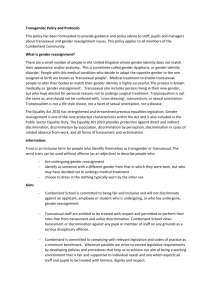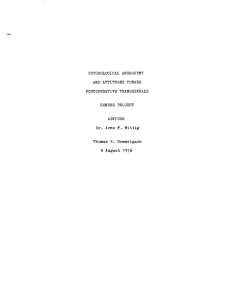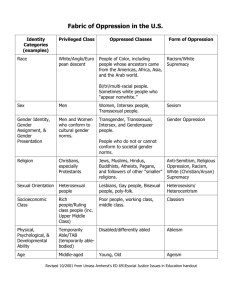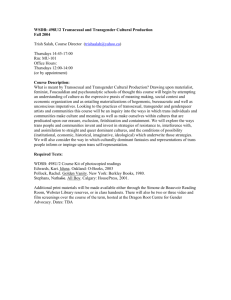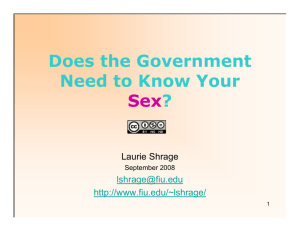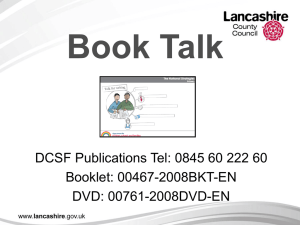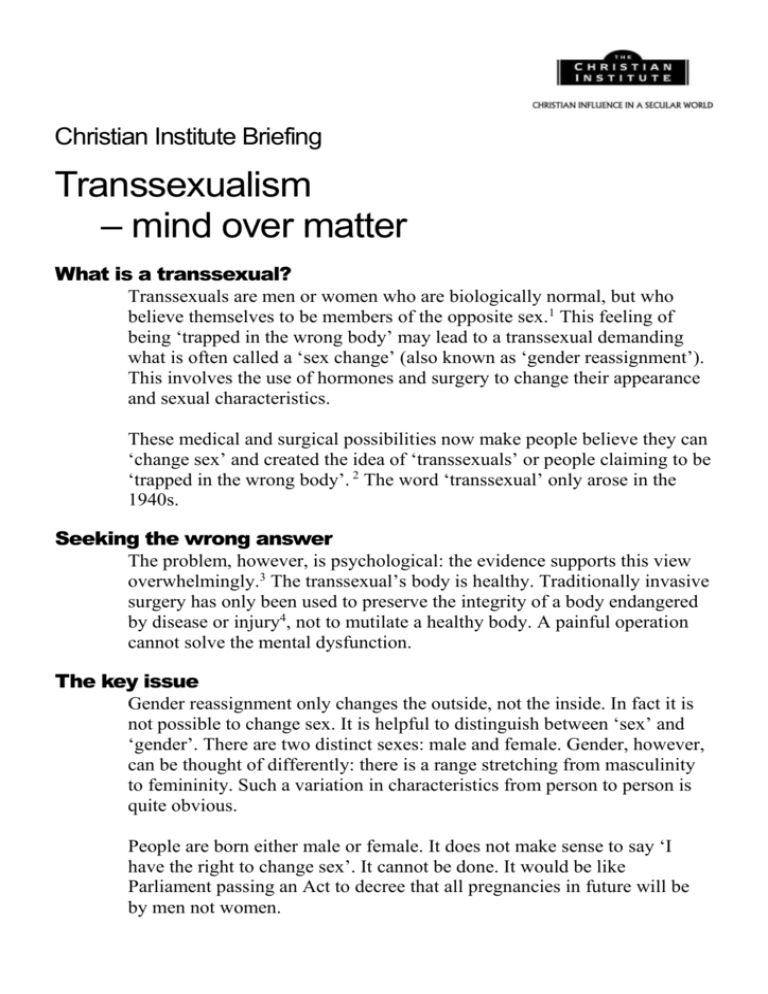
Christian Institute Briefing
Transsexualism
– mind over matter
What is a transsexual?
Transsexuals are men or women who are biologically normal, but who
believe themselves to be members of the opposite sex.1 This feeling of
being ‘trapped in the wrong body’ may lead to a transsexual demanding
what is often called a ‘sex change’ (also known as ‘gender reassignment’).
This involves the use of hormones and surgery to change their appearance
and sexual characteristics.
These medical and surgical possibilities now make people believe they can
‘change sex’ and created the idea of ‘transsexuals’ or people claiming to be
‘trapped in the wrong body’. 2 The word ‘transsexual’ only arose in the
1940s.
Seeking the wrong answer
The problem, however, is psychological: the evidence supports this view
overwhelmingly.3 The transsexual’s body is healthy. Traditionally invasive
surgery has only been used to preserve the integrity of a body endangered
by disease or injury4, not to mutilate a healthy body. A painful operation
cannot solve the mental dysfunction.
The key issue
Gender reassignment only changes the outside, not the inside. In fact it is
not possible to change sex. It is helpful to distinguish between ‘sex’ and
‘gender’. There are two distinct sexes: male and female. Gender, however,
can be thought of differently: there is a range stretching from masculinity
to femininity. Such a variation in characteristics from person to person is
quite obvious.
People are born either male or female. It does not make sense to say ‘I
have the right to change sex’. It cannot be done. It would be like
Parliament passing an Act to decree that all pregnancies in future will be
by men not women.
The Bible
The reason that there are two, and only two, sexes is that God created
mankind such that to be human means to be either human male or human
female (Genesis 1:27). The human body is therefore a good gift of God and
essential to the human person. But the transsexual sees their body as an
accident, as denying their ‘true self’ which resides in their mind and
emotions. This is opposed to the Bible, which teaches a positive view of
the body: the supreme expression of this being that Jesus became flesh
(John 1:14). It is an old heresy (‘Manichaeanism’) which detaches the
person from the body.5
1 Corinthians 6:18-20 warns against ‘sinning sexually against your own
body’. Christians must honour God with their body.
The Old Testament uses the same word to condemn homosexual practice
and intentional cross-dressing. Deuteronomy 22:5 states: “A woman must
not wear man’s clothing, nor a man wear woman’s clothing, for the LORD
your God detests anyone who does this.” (compare Leviticus 18:22).
What about the law?
In July 2002 the European Court of Human Rights held that a transsexual
has the human right to change sex and to marry someone of the same
biological sex.6 But until now British law has been in harmony with
Christian belief. In the court case Corbett v Corbett, Mr. Corbett argued
that his marriage was void because his ‘wife’ was a man. Mr. Justice
Ormrod agreed. He upheld the principle that biology determines the sex.7
A male-female transsexual who had undergone ‘gender reassignment’
remained as he was ever since birth: male. Ormrod upheld that three facts
determined the sex of a person:
1. The chromosomes (XY – male; XX – female)
2. The gonads (testes/ovaries)
3. The genitals (penis/clitoris, including internal sex organs)
Ormrod also held that the man was psychologically a transsexual.
Gay marriage
In Corbett v Corbett the marriage of a transsexual male-female to a male
was declared void because both parties were biological males.
The Gender Recognition Bill, introduced in Parliament in November 2003,
allows transsexuals to marry. It does this by allowing them to swap the sex
recorded on their birth certificate. But this is fundamentally dishonest. You
cannot alter a fact of history. If the Bill becomes law, it will open the door
to gay marriage. Transsexual marriage is gay marriage since legally two
men, or two women, of the same sex would be married.
The arguments
There are claims that a person’s sex is the product of a gradual process
determined by society. This is clearly opposed to Scripture. The objective
fact is that the XY or XX chromosomal/genetic pattern is set at conception.
Nor is it reasonable to assume that other biological factors, e.g. brain
structure, cause transsexualism. There is little evidence for this and the
plea ‘I was made this way’ was abandoned by biologists long ago.8
Even if psychology were a factor in determining sex, why should it
overrule all other factors?
What transsexualism is not:9
1. Transvestism. A transvestite is someone who cross-dresses for erotic
stimulation, usually a man who dresses as a woman.10 This is not the
reason why a transsexual would dress as the opposite sex.
2. Homosexuality. A homosexual wants to fulfil same-sex desires with their
body as given. They do not see their body as a problem.
3.
A biological ‘intersex’ condition, also called ‘hermaphroditism’. There are
very rare cases of babies whose sex at birth is ambiguous. True
hermaphrodites are born with both testicular and ovarian tissue. One
world-wide review found only 364 cases of true hermaphrodites since
1899.11 Another intersex condition, involving ambiguous genitalia, is
thought to occur in 1 in 130,000 births.12 Such illnesses have nothing to do
with transsexualism. A transsexual has a healthy body.
Problems for transsexuals
There is evidence that some transsexuals attempt suicide, become involved
in prostitution and that some transsexuals regret having their operation:
even ‘returning’ to their biological sex.13 It has also been claimed that
hormonal treatment can result in breast cancer.14
The Christian response to a transsexual, as with any other person, should
be prayer, care and counsel as for any with psychological difficulties and
where necessary repentance and faith in Jesus Christ. (Acts 20:21)
Transsexualism – mind over matter
© The Christian Institute, February 2002
Updated December 2003
2nd Floor, Block A,
Scottish Life House
Archbold Terrace
Newcastle upon Tyne
NE2 1DB
Tel: 0191 281 5664
Fax: 0191 281 4272
info@christian.org.uk
http://www.christian.org.uk
References:
‘Transsexualism’ in Atkinson, D J and Field, D H (Eds.) New Dictionary of Christian Ethics and Pastoral Theology, IVP,
1995, page 863. It is a rare condition. The American Psychiatric Association has estimated that 1 in 30,000 males (0.003 per
cent) and 1 in 100,000 females (0.001 per cent) are transsexuals: Diagnostic and Statistical Manual of Mental Disorders (Third
Edition – Revised), The American Psychiatric Association, 1987, page 75. More recent studies have shown a higher prevalence,
but there is no reason to believe they are more accurate: see Transsexuality- a report by the Evangelical Alliance Policy
Commission, 2000, page 16.
2 Transsexuality, Op cit, page 12. The idea is distinct from cross-dressing.
3 Ibid, page 22
4 O’Donovan, O, Transsexualism and Christian Marriage, Grove Booklet on Ethics, 1982, page 15
5 Ibid, page 6
6 Goodwin v. United Kingdom and I. V United Kingdom (2002) 35 EHRR 447; The Times, 12 July 2002
7 Corbett v Corbett (otherwise Ashley) [1970] 2 All ER 33
8 Whitehead, N, ‘Are Transsexuals Born that Way?’, Triple Helix, Autumn 2000, Christian Medical Fellowship, page 7
9 ‘Transsexualism’ in Atkinson, D J and Field, D H (Eds.), Op cit, page 864
10 Transsexuality, Op cit, page 6
11 van Niekirk, W A, ‘True Hermaphroditism’, Am. J. Obstet. Gynecol., 126(7), 1976, pages 890-907
12 ‘Partial androgen insensitivity syndrome’: see http://www.isna.org/faq/frequency.html as at 14 February 2002
13 Diagnostic and Statistical Manual of Mental Disorders, Op cit, page 75; O’Donovan, O, Op cit, page 4; Califia, P, Sex
Changes- The Politics of Transgenderism, Cleis Press, 1997, page 246; Whitehead, N, Op cit, pages 6-8
14 MacKenzie, G O, Transgender Nation, Bowling Green State University Popular Press, 1994, page 71 citing Prior J, Vigna, Y
and Watson, D in ‘Spironolactone with Psychological Female Steroids for Presurgical Therapy of Male-to-Female
Transsexuals’, Archives of Sexual Behavior, 18(1), 1989, pages 49-57
1


